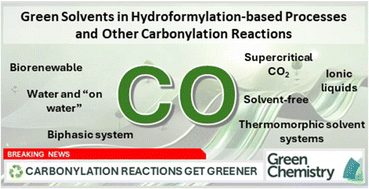Carbonylations are an important class of reactions that involve the addition of carbon monoxide (CO) to organic substrates in the presence of nucleophiles, leading to the formation of carbonyl-containing compounds. Despite its security issues, CO is a cheap feedstock, widely used in the chemical industry, that can be produced by sustainable processes. Usually, carbonylations are catalysed by transition metal complexes in solution, and solvents are employed. As solvents have a major impact on the sustainability of industrial processes, the focus of this review is the use of greener or more sustainable solvents for reactions involving carbonylations. The recent literature on hydroformylation, tandem reactions involving hydroformylation, hydroxycarbonylations, alkoxycarbonylations, aminocarbonylations, and other miscellaneous carbonylations was broadly covered. Aspects regarding renewable feedstocks, more efficient synthetic protocols (one-pot and tandem processes), milder reaction conditions, and easier catalyst recovery were also highlighted.
